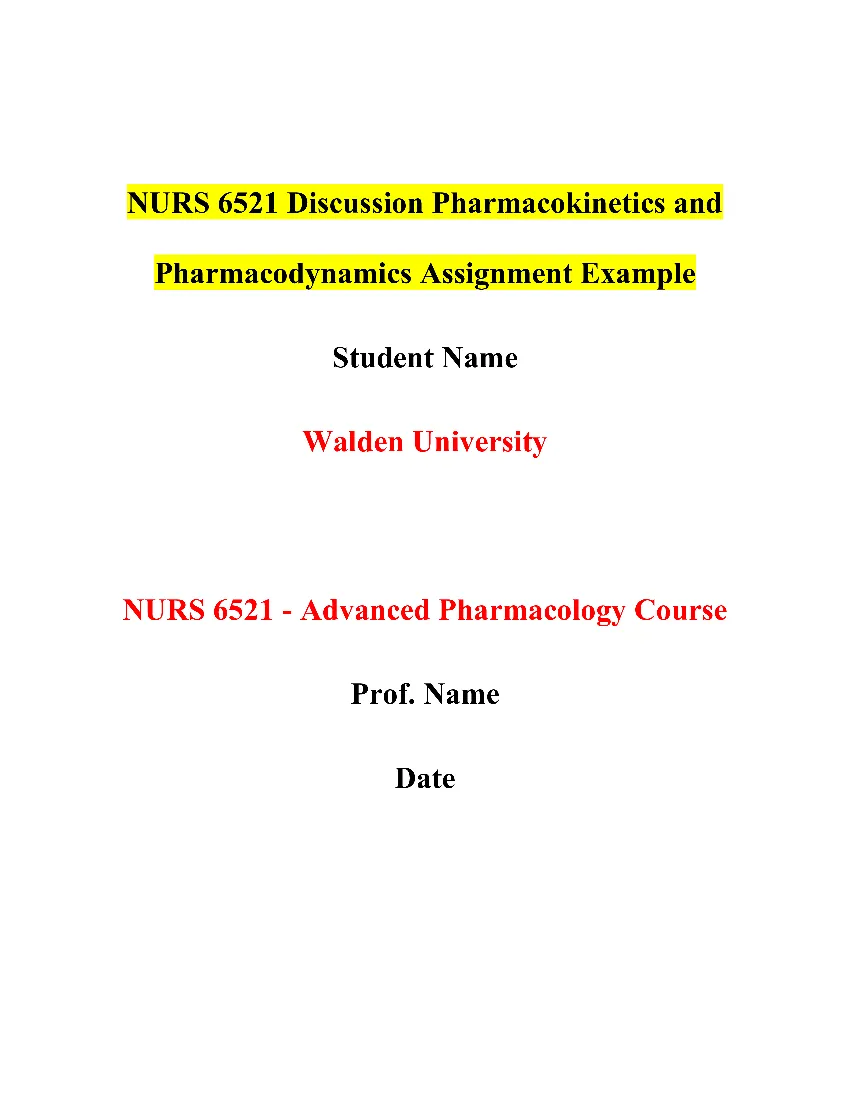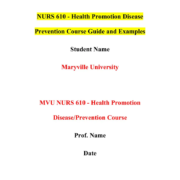NURS Evidence-Based Practice PICO Question Development for Postpartum
 Assignment Brief: Evidence-Based Practice PICO Question Development for Postpartum
Assignment Brief: Evidence-Based Practice PICO Question Development for Postpartum
Assignment Instructions Overview:
In this assignment, you will delve into the realm of evidence-based practice (EBP) by formulating a PICO (Patient/Population, Intervention, Comparison, Outcome) question addressing a clinical problem pertinent to family nursing practice, specifically focusing on postpartum care. The objective is to develop a question that will guide your exploration of available literature, the development of a plan for potential practice changes, and the creation of a presentation to disseminate your findings.
Understanding Assignment Objectives:
Identifying a Clinical Problem:
- Your task is to identify a clinical problem within the scope of family nursing practice, specifically in postpartum care (primary care). This problem should give rise to a foreground question with a comparison, forming the basis for your PICO question.
PICO Components:
- Develop the PICO components using clear and concise language.
- P (Patient/Population/Problem): Specify the population or problem (e.g., postpartum women without a history of mental disorders experiencing postnatal depression).
- I (Intervention): Define the intervention under consideration (e.g., individual-based telemedicine interventions).
- C (Comparison): Identify the comparator (e.g., standard in-person therapy sessions).
- (Outcome): Describe the desired outcome(s) (e.g., improved access to mental health care and a decrease in depressive symptoms within the first six months postpartum).
Initial EBP Question:
Write an initial EBP question by combining the PICO components. This question will be the cornerstone of your future assignments, and it must be answerable using current research literature (preferably less than 5 years old).
The Student’s Role:
As a student undertaking this assignment, your role involves:
- Critical Thinking: Engage in critical thinking to identify a relevant clinical problem in postpartum care. Consider the challenges faced by postpartum women without a history of mental disorders and the potential benefits of different interventions.
- Literature Review: Conduct a comprehensive literature review by exploring studies related to postpartum care, telemedicine interventions, and mental health outcomes. This exploration will support the formulation of your EBP question and provide a foundation for future assignments.
- Question Development: Apply the Johns Hopkins Evidence-Based Practice Model to develop your PICO question. Ensure that it is specific, focused, and answerable within the parameters of current research literature.
- Integration of Findings: Integrate findings from relevant studies to support your PICO question. Consider the nuances and variations in interventions and outcomes presented in the literature.
- Communication: Communicate your question clearly and concisely. Your question should reflect a thoughtful consideration of the chosen population, intervention, comparison, and outcomes.
Original Question Background Description:
Clinical questions often arise from day-to-day problems encountered by clinicians, administrators, and nurse educators. For this assignment, you will need to identify a clinical problem relevant to family nursing practice (primary care). The question you develop for this assignment will be used throughout this semester as you search for evidence to answer your clinical question, develop a plan to implement a possible practice change and develop a presentation to disseminate your findings.
It should be a foreground question with a comparison.
Please use the attached PICO Question Development page to tell us about your phenomenon of interest.
You will:
- Develop the PICO components
- Write the initial EBP question
The PICOT question will be the basis of all of your future assignments for this course. It MUST be EBP (Not research or QI) and it should be answerable using the available current research literature (less than 5 years, preferably less than 2-3 years).
Evidence-Based Practice PICO Question Development for Postpartum Example
Introduction
The clinical question addressed in this paper revolves around the use of individual-based telemedicine interventions as an alternative to standard in-person therapy sessions for postpartum women without a history of mental disorders who are experiencing symptoms of postnatal depression. The Johns Hopkins Evidence-Based Practice Model for Nursing and Healthcare Professionals’ Question Development Tool was employed to structure the question, using the PICO (Patient/Population, Intervention, Comparison, Outcome) components.
PICO Components
- Patient/Population/Problem (P): Postpartum women (with no history of mental disorders) experiencing symptoms of postnatal depression.
- Intervention (I): Individual-based telemedicine interventions.
- Comparison (C): Standard in-person therapy sessions.
- Outcome (O): Improved access to mental health care and a decrease in depressive symptoms within the first six months postpartum.
Initial EBP Question
The initial evidence-based practice (EBP) question that emerged from the PICO components is as follows: In postpartum women (with no history of mental disorders) experiencing symptoms of postnatal depression, does individual-based telemedicine interventions (compared to standard in-person therapy sessions) result in improved access to mental health care and a decrease in depressive symptoms within the first six months postpartum?
The rationale for the Question
The development of this question is rooted in the aim to explore the effectiveness of individual-based telemedicine interventions in managing postpartum women experiencing postnatal depression symptoms. The comparison with standard in-person therapy sessions provides a basis for evaluating the potential benefits of telemedicine in this specific population. The desired outcomes include improved access to mental health care and a reduction in depressive symptoms within the crucial first six months postpartum.
Literature Review
To support the formulation of this EBP question, a comprehensive review of the relevant literature was conducted. Several studies were identified:
- Hanach et al. (2021) conducted a systematic review and meta-analysis, evaluating the effectiveness of telemedicine interventions exclusively during the postnatal period on postpartum depression in mothers without a history or existing mental disorders. Their findings contribute valuable insights into the potential benefits of telemedicine in managing postpartum depression.
- Parameswaran et al. (2022) explored the experiences of women with perinatal depression regarding the use of technology and telehealth. Understanding the user perspective is crucial in assessing the feasibility and acceptability of telemedicine interventions in this context.
- Paul et al. (2021) adapted perinatal mental health mother–infant group programming for telehealth during the COVID‐19 pandemic. Their work provides insights into the adaptability of mental health interventions for perinatal populations during challenging circumstances.
- Stentzel et al. (2023) conducted a systematic literature review on mental health-related telemedicine interventions for pregnant women and new mothers. This review offers a comprehensive overview of the existing evidence on telemedicine interventions in this specific population.
- Zhao et al. (2021) conducted a systematic review and meta-analysis on the effectiveness of telehealth interventions for women with postpartum depression. Their findings contribute to the overall understanding of the efficacy of telehealth interventions in managing postpartum depression.
Conclusion
In conclusion, the developed EBP question focuses on the comparison between individual-based telemedicine interventions and standard in-person therapy sessions for postpartum women experiencing symptoms of postnatal depression. The literature review highlights the existing evidence and insights from various studies, laying the groundwork for future research and practice in this critical area of family nursing. This question will guide further exploration, evidence gathering, and the development of a plan for implementing potential practice changes based on the available current research literature.
Unleash Your Academic Potential with ReliablePapers.com – Your Go-To Nursing Essay Writing Service
Are you drowning in the challenges of nursing essay assignments? Don’t let the complexities of certain topics overwhelm you. At ReliablePapers.com, we pride ourselves on being the best nursing paper writing service company dedicated to easing your academic burden. The sample provided on Evidence-Based Practice PICO Question Development for Postpartum is just a glimpse of what we can offer.
Why stress over tough topics when our expert nursing essay writers can craft a unique and customized nursing essay specifically for you? We guarantee originality, ensuring you never submit a plagiarized paper. Worried about your budget? Our online nursing papers come at incredibly affordable prices, making academic assistance accessible to all college students.
Our professional writers excel in handling complex topics, tight deadlines, and specific instructions. Whether you need a guide for your phenomenon of interest nursing paper or a comprehensive nursing coursework writing help, we’ve got you covered.
Save your time for what matters most and let our pro writers perfect your nursing paper. Seek the help of ReliablePapers.com for a stress-free academic journey!
Unlock your academic success with ReliablePapers.com – your reliable partner in nursing essay excellence!
Hire an Expert Paper Writer on Any Subject, Any Topic, Any Deadline! Submit your paper instructions by placing your order here to get started!



 NURS 6521 Discussion Pharmacokinetics and Pharmacodynamics Assignment
NURS 6521 Discussion Pharmacokinetics and Pharmacodynamics Assignment
 FIR 3305 UNIT IV: Justification Paper for Residential Sprinkler and Alarm Systems Assignment Brief
FIR 3305 UNIT IV: Justification Paper for Residential Sprinkler and Alarm Systems Assignment Brief FIR 2305 Unit VII: Assignment Brief
FIR 2305 Unit VII: Assignment Brief![FSC 3345/FIR 2305 Unit VI: Understanding the Importance of Fire Investigation [Solved]](https://reliablepapers.com/wp-content/uploads/2023/10/Understanding-the-Importance-of-Fire-Investigation-180x180.webp) FSC 3345/FIR 2305 Unit VI: Understanding the Importance of Fire Investigation Assignment Brief
FSC 3345/FIR 2305 Unit VI: Understanding the Importance of Fire Investigation Assignment Brief UNIT V Journal Assignment Brief
UNIT V Journal Assignment Brief FIR 2305/FIR 3303 UNIT II: Characteristics and Goals of Public and Private Fire Prevention and Protection Organizations Assignment Brief
FIR 2305/FIR 3303 UNIT II: Characteristics and Goals of Public and Private Fire Prevention and Protection Organizations Assignment Brief Maryville NURS 610 – Health Promotion Disease Prevention Course Description
Maryville NURS 610 – Health Promotion Disease Prevention Course Description